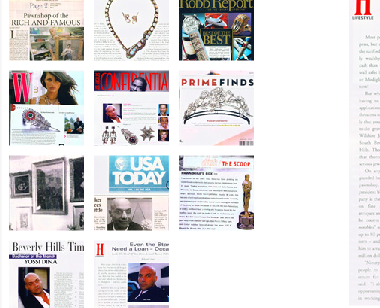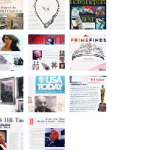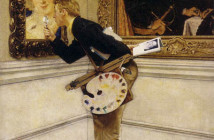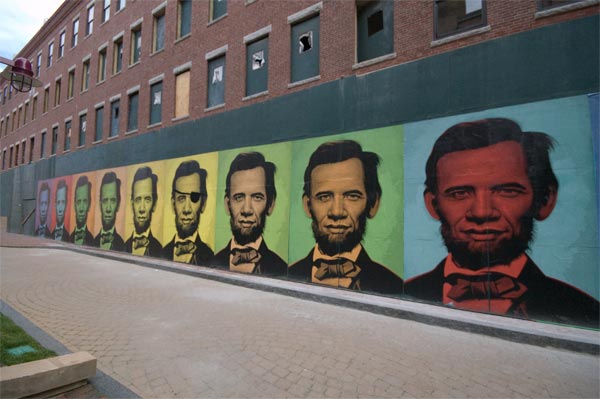In the course of a week, Yossi Dina talks to a lot of art dealers and art collectors, movie moguls and real estate investors, all of whom want him to give them a loan, using their art as collateral. "Almost every day, people want to know what their art is worth, what kind of loan I give them," he said. Not everybody is so nice. "A lot of people try to scam me. They think I don’t know anything about art or what something is worth. They think I’ll take a fake, but I’m not stupid, and they learn pretty quickly."
In the small world of loans where art is accepted as collateral, Yossi Dina is one of the go-to guys. A few banks will permit their long-time "preferred" customers, whose diversified portfolios they manage, to put up artworks along with other assets against borrowed money. The New York City-based Rosenthal & Rosenthal is a private loan company that will take art as collateral, and the largest auction houses -- Christie’s, Phillips and Sotheby’s -- make advances against consignments and for planned bidders. And then there is Dina, owner of The Dina Collection, a Beverly Hills pawn shop that specializes in the fine arts. The banks, the financial services companies and the auction houses can take a while to agree to a loan, but Dina generally makes a determination while you’re standing, later that day if things are more complicated. Selling art through galleries and auction houses usually takes even longer.
If the United States slides into a recession, as many economists are predicting, those with nonliquid assets, such as artwork and jewelry, may be looking convert some of their holdings into cash. The benefit of a pawn shop is that someone doesn’t lose possession of an object unless he or she decides to default on the loan; and it is a type of default that won’t appear on a credit report — you just keep the money you received. The downside of a pawn shop loan is that the money is never equal to the value of the object that is handed over.
Most of the loans that Dina makes are between $2,500 and $500,000, occasionally based on prints but more often unique works by such artists as Marc Chagall, Salvador Dali, Amedeo Modigliani, Pablo Picasso, Ed Ruscha and Andy Warhol. "Most of my loans, relative to other pawnbrokers, are large," he said. "Most pawnbrokers make loans of $50-100. My average is over $10,000, and I don’t do 100 loans a day."
On occasion, the loans get into the million-dollar level, such as a recent deal involving 10 artworks on which he paid out "a little under $4 million."
The art owners needing money "are just normal people, not on drugs or anything. They don’t come here out of desperation," he added. They just need cash right now, perhaps to "buy more art or invest in something, like buying a building." Well, some may be a little desperate, such as the movie and television industry people who have been out of work as a result of the writers’ strike. In Beverly Hills , someone always needs emergency money to pay a lawyer or to bail a kid out of jail, an art gallery owner whose last exhibition produced no sales need money to pay the rent. It’s none of Dina’s business why they need the money, and he claims to never ask, although the information is sometimes volunteered.
He makes four-month loans, charging four percent interest per month — the maximum allowed under the California penal code — and will roll over the loan for another four months at the clients’ request ("I try to be nice"). As any other pawn shop doing business in his location, The Dina Collection is incorporated under California law, has both a state and city (of Beverly Hills) pawn brokers license, obtained a resellers permit and posted a $100,000 bond.
State law requires pawn shop records to be available to law enforcement agencies, but otherwise all loan information is confidential. All pawn brokers loan a percentage of the amount that they can expect to receive if they have to sell the item in the event that the borrowers do not come back to get it. Under state law, and true in all 50 states, borrowers are required to present a state issued picture identification card or drivers license; other forms of identification, such as a birth certificate, car registrations, health insurance cards, passports, student ID, fishing license, hunting license, library card, credit card or company employee tag, are not permissible. After the four months is up (plus a 10-day grace period), unless the borrower requests an extension on repaying his or her loan, ownership of the item reverts to the pawn shop owner.
California and New York State banking laws, which regulate pawn shops, both permit no more than a four percent per month interest rate, or 48 percent annually. Many other states are more lenient towards pawnbrokers, allowing annual interest rates of 120 percent, or 10 percent per month. That is in addition to storage fees (a wide and negotiable range, based on the size of the object — cars and trucks take up more room than most art and jewelry) and processing fees (sometimes a set amount and other times a percentage of the loan — perhaps one or two percent). Nationally, two-thirds of pawned items are retrieved, particularly objects of greater value, according to John P. Caskey, chairman of the department of economics at Swarthmore College , who has studied the pawn shop industry. "The pawn shop owner will lend you some fraction of the resale value, so you have a strong interest in getting it back," he said. "Say, you bought a watch for $200 and bring it into a pawn shop. The owner will think that he can sell it for $100, so give you $50 for it. It makes sense for you to get it back as soon as you can."
Dina noted that one of the artworks he has in his shop is a painting that he quickly determined by looking through auction records had a fair market value of $10 million. He loaned its owner $1 million. "The state doesn’t tell me how much I have to pay people," he said. "There is no logic to my business." Still, most of his high-end customers must understand logic, since Dina claimed that more than 90 percent of them redeem their artwork within a year or less. Dina wastes no time selling unretrieved artwork, as well as other art he purchases from estate and bankruptcy sales ("Every day I get a deal") — the artwork (Impressionism, Modern and contemporary art, with an occasional Old Master) forms The Dina Collection. "I sold more art last year than most galleries," he boasted, crediting his success to being able to underprice mainstream commercial galleries. The actor George Hamilton is one of his buyers, he added.
Since Dina is only licensed to make loans in Beverly Hills , all transfers of artwork and money must take place in person. Telephone inquiries come in from all over the United States -- images of the artwork are sent as JPEGS through e-mail, and other documentation is faxed -- but he (as all pawn brokers) wants to see the object in person; those would-be borrowers to whom he agrees to make a loan are required to travel to Beverly Hills . "My clients know it’s worth it to make the trip." Borrowers must also retrieve their items in person or designate in writing at the time of the initial loan who else can pick it up.
The popular image of the pawn shop is a seedy store front with bullet-proof glass in a seedy neighborhood, frequented by people who are clearly down on their luck, trading their wedding rings or cars for rent or food money. Many are still like that, but Caskey noted that a new crop of pawn shop has emerged, serving a higher-end clientele. "There has been an effort to upscale the image," he said. "The chain pawn shops are more sophisticated, well-lit, clean, spacious, more like a 7-11." The names of the more upscale pawn shops also don’t suggest hard times, such as The Dina Collection or Carver W. Reed in Philadelphia , which specializes in jewelry, and they are located right in the higher-rent commercial districts of their respective cities.
Yossi Dina is not the only pawn broker to accept artwork, although jewelry tends to be their highest priced valuable. The Dina Collection is the art branch of the South Beverly Wilshire Jewelry and Loan, also owned and operated by Dina and located in the same building on a street filled with high-end jewelry shops. The Yuppie Pawn Shop in Kirkland, Washington, Buy Sell Loan in the San Francisco Bay Area and The Cash Store in Fairfax, Virginia also highlight their willingness to make loans collateralized by artwork. Having a nicer looking store and paying higher rent for it doesn’t make these pawn shop owners any less avaricious. "The loans we make aren’t anywhere near what the things are worth," said Karen Moskowitz, co-owner of The Yuppie Pawn Shop, which has taken as collateral works by Dale Chihuly, Salvador Dali and Bev Doolittle. "We probably give 10-30 cents on the dollar." Dmitri Bertsovsky, owner of Buy Sell Loan stated that he pays out 25-30 percent of the actual value for "bronzes, oil paintings, porcelains, and only by listed artists" — that is, artists who have an auction sales record.
The Dina Collection, however, is the largest and Dina himself has been labeled "pawnbroker to the stars." (Among the people who have bought jewelry from him, according to employee Dominique, are Farrah Fawcett, Janet Jackson and Liza Minelli.)
The 50 year-old Dina was born in Israel and came to the United States in 1979 to visit his brother, who lived in New York City . He hitch-hiked across the country, settling in Los Angeles and earning money along the way selling jewelry. "I used to do just a jewelry pawn shop," he said, "and then I dated a girl who was into art, and her father was a collector." The relationship with the girl did not last, but his interest in acquiring and selling art grew, because "there was no competition in art. People who have art and need money right away, where else are they going to go?"
- Snippet from The Dina Collection’s website, featuring Yossi Dina’s recent press coverage.
- Yuppie Pawn Shop, in Washington State, is another pawn broker marketing itself to more upscale clientele.
The Dina Collections
Rosenthal & Rosenthal
The Yuppie Pawn Shop
Buy Sell Loan
The Cash Store
Thubmail image from Associated Press, via the BBC.






